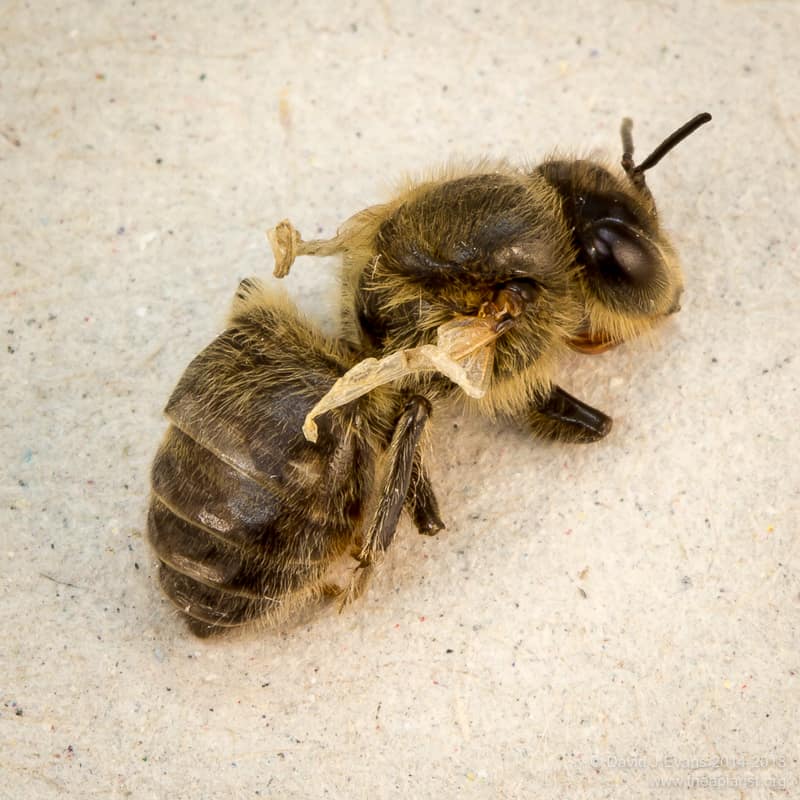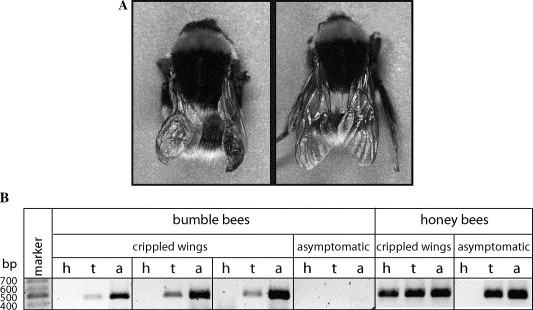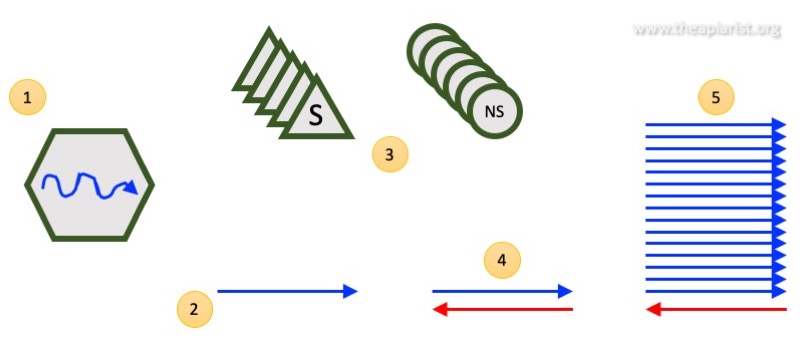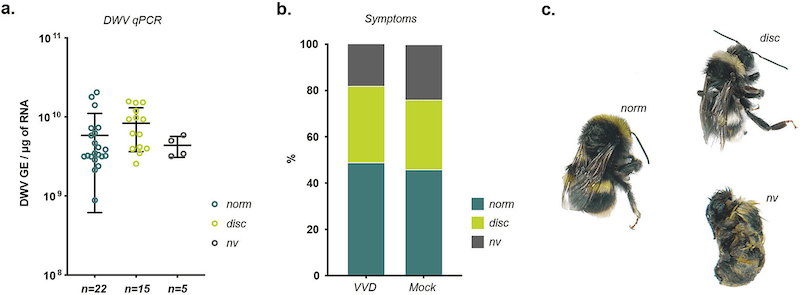Does DWV infect bumble bees?
Covid (the disease) is caused by a virus called SARS-Cov-2. SARS is an abbreviation of severe acute respiratory syndrome and the suffix ‘Cov’ indicates that it’s a coronavirus. The final digit (2) shows that it’s the second of this type of virus that has caused a pandemic. The first was in 2003, and was caused by a virus we now call SARS-Cov-1. That virus had a case fatality rate of 11%, but only infected ~8500 people worldwide.
SARS-Cov-2 is not a human virus, by which I mean it’s not a virus that has been present in the human population for a long time. It’s actually a virus that most probably originated in bats.
We’re still not sure how SARS-Cov-2 jumped species from bats to humans.
SARS-Cov-1 made the same transition from bats and we do have a pretty good idea how this happened. Before the virus was found in bats it was detected in palm civets and raccoon dogs, both of which are farmed for food and sold in live game markets. Neither animal shows any symptoms when infected with SARS-Cov-1.
Bats were also sold in the same live game markets in Guangdong province in China and it seems likely that the virus either crossed directly from bats to humans, or went via a third species such as the palm civet.
Pathogen spillover
It’s likely that SARS-Cov-2 followed the same route. We are entering a second – likely extended – period of geographic lockdown due to Covid. Since SARS-Cov-2 made its cross-species jump from bats to humans it has infected at least 41 million people and killed over 1.13 million.
Pathogens that jump from one species to another can have catastrophic consequences for the recipient population {{1}} or, as in the case of palm civets, might cause no harm whatsoever.
The term ‘pathogen spillover’ is often used to describe the event when a pathogen – whether viral, bacterial or a parasite – escapes or spills over from its natural host to another species.
CSI in the apiary … motive, opportunity, means
To make the species jump a number of criteria must occur. The pathogen has to be present at a high enough level to be infectious in the ‘donor’ species. For convenience, let’s consider this as the motive to jump species {{2}}.
Secondly, the pathogen needs to have an opportunity to jump species. For example, because the donor and ‘recipient’ species share the same habitat or regularly come into contact.
Finally, it has to have the means to replicate in the recipient. If it cannot replicate it can never get established in the recipient population or cause disease.
In fact, this is an oversimplification. It also needs to be transmissible between individuals of the recipient species (or it will never spread in the recipient species).
So what has all this to do with the bumble bees in the title of this post?
Honey bees get a bad press from some scientists and environmentalists. They compete with native solitary and other bees and pollinators for environmental resources – like pollen and nectar. Increasingly, particularly in agricultural areas, these can be in limiting supply at certain times of the season. For examples, because all the hedgerows have been grubbed up and the wildflower meadows obliterated.
In addition, there are a number of studies that have suggested that honey bee viruses have spilled over into other pollinators, in particular bumble bees, and that this pathogen spillover has contributed to the decline in free-living bee populations.
Do honey bee viruses have the motive, opportunity and means to cause disease in bumble bees?
Are honey bee viruses responsible for the decline in bumble bee populations?
Correlation and causation
There are numerous studies showing that the most widespread honey bee virus, deformed wing virus (DWV), can be detected in wild-caught bumble bees.
Let me pose a quick question … does detection mean ‘replication’?
Deformed wing virus “does what it says on the tin” in honey bees. When transmitted by Varroa it causes developmental defects in pupae that appear as wing deformities in newly emerged workers.
There’s also one study that implicates DWV in directly causing disease in bumble bees.
This influential paper, published 15 years ago, demonstrated that some bumble bees had the characteristic crippled wings seen in symptomatic emerging honey bee workers. The ‘smoking gun’ was that DWV was also detected in these bumble bees.
This is the only figure in the paper and there have been no substantive follow-up papers. For some reason they showed ‘symptomatic’ Bombus terrestris (the buff-tailed bumble bee; panel A, left) and PCR detection data for B. pascorum (the common carder bee).
Nevertheless, this association between presence and symptoms was sufficient for the authors to conclude “we demonstrated that DWV is pathogenic to at least two bumble bee species … causing wing deformity similar to clinically DWV-infected honey bees”.
Here’s a second important question … does the detection of DWV in bumble bees demonstrate it is responsible for the symptoms observed? {{3}}
As a virologist interested in the evolution, replication and transmission of viruses – and a beekeeper – this seemed like a worthwhile topic to explore in a bit more detail.
There might be a correlation between the presence of DWV in bumble bees, but does this account for causation of the DWV-like symptoms seen in the bumble bees?
Motive and opportunity
Let’s get these two out of the way quickly (though we’ll return to opportunity in the notes at the end).
Remember, viruses don’t want to do anything. I’m using motive as a hideously contrived reference to whether the pathogen, DWV, is present at high and infectious levels in honey bees.
It is.
Healthy, mite-naive (but reared in a hive with Varroa) workers can carry as little as ~1000 DWV viruses. Similar levels of DWV are also present in hives from Varroa-free regions – at least of the UK {{4}}. In contrast, after parasitisation by Varroa, symptomatic or asymptomatic adult worker honey bees regularly have more that 109 (one trillion) viruses coursing through their little bodies.
This virus is highly infectious. When injected into honey bees, as few as 10 viruses are sufficient to start a new infection and are replicated several million-fold within 24-48 hours.
Let’s agree that they have the ‘motive’ … to spread to other hosts.
They also have the opportunity, at least in the broadest sense of the word. Honey bees and bumble bees share the same environment. They collect nectar and pollen from the same flower species. They can even regularly be seen visiting the same flower simultaneously. In addition, it’s not unusual to see bumble bees trying to access honey bee hives to steal nectar.
I’d argue that the virus appears to have ample opportunity to move from one species to the other.
Does DWV replicate in bumble bees?
This is an important question. The data figure (‘Exhibit A’) shown above does not answer this question. Their assay simply detects the presence of DWV, with no indication of whether the virus is replicating.
And the reason this is important is really explained in the section on motive and opportunity above. DWV is ubiquitous and present at extraordinarily high levels in many honey bees. It’s present in honey bee faeces. It can be detected on flowers that honey bees have visited, or in pollen collected from those flowers.
DWV is absolutely everywhere.
So, if it is everywhere, there’s a good chance it might simply contaminate things … like bumble bees that look a bit sick for other reasons.
However, if DWV is involved in causing disease in bumble bees then the virus must replicate in bumble bees.
I’ve used this figure before. To be certain that the virus is replicating you need to identify the intermediate replication products (the negative strand RNA shown as red arrows above).
Almost none of the large number of papers that have reported “DWV infected bumble bees” have identified these intermediate replication products.
Many studies didn’t even bother looking for these critical intermediate products.
So we did
There are two ways we could have investigated this. We could have collected large numbers of bumble bees from the fields and screened them in the lab for these replication intermediates. The problem with this approach is that DWV might be very rare in bumble bees, or might be common, but only replicate rarely. The additional problem is that it involves going out and collecting bees from the environment – that’s hard work ? {{5}}
An alternative approach is to buy a nest of bumble bees {{6}} and to inject a few bumble bee pupae and adults with DWV. This is what we did. In parallel, to ‘prove’ the virus used can replicate in honey bees, we injected a few honey bee pupae.
We injected the bees as it’s the definitive way we have of being sure that the virus was present.
‘Gene jockeys’
I’ve got some gifted molecular virologists in my lab. These are scientists who use genetic engineering or biotechnology techniques to address tricky questions (gene jockeys). They are particularly skilled at manipulating nucleic acids, such as the genomes of viruses.
If DWV is so common (it is – see above) how would we know that the replication intermediates were from the virus we injected into the bumble bees, rather than from a virus that was possibly already present?
To solve this puzzle Alex (the lead author on our recent paper) did two things. She engineered a unique genetic marker into the virus which we could look for (and that knew was absent from other similar viruses that might already be present in bumble bees). In addition, she ensured that the virus she injected into the bumble bees contained none of the negative strand RNA that is produced as the intermediate when the virus replicates.
And … to cut a long story short, we could detect the negative strand RNA replication intermediate in injected bumble bees. In addition, the virus contained the unique genetic marker Alex had engineered into the virus genome, so we were absolutely certain it was the injected virus that was replicating. All of the controls worked exactly as expected.
DWV does replicate in bumble bees … at least under the conditions used in our experiment.
But it does not replicate very fast
The bumble bees we used for these experiments are commercially produced under very clean conditions. When we tested control bumble bees they contained no DWV at all, even using our most sensitive assays.
In contrast to injected honey bee pupae, DWV replicates rather slowly in bumble bees. In honey bees it will amplify a million-fold in 48 hours. However, in bumble bees, in 48 hours we only observed a 100-10,000 fold increase in DWV levels. It was only when we injected large amounts of DWV to bumble bees that we could recapitulate the virus levels seen in symptomatic honey bees.
This was a little puzzling as we’ve assumed that the very rapid replication of DWV in honey bees contributes to pathogenesis. The virus needs to replicate fast to spread through the pupa and infect the particular tissues and organs that, when damaged, result in the characteristic symptoms seen.
If it only replicates slowly in bumble bees how can it cause symptoms?
But hold on … does it cause symptoms?
Not as far as we can tell.
We never found any injected bumble bees with deformed wings, or any that looked anything like the symptoms seen with DWV in honey bees. The actual quote from the paper is:
“Strikingly, none of the eclosed bumble bees showed any signs of the wing deformities that are characteristic of DWV infection of honey bees”.
Injected pupae developed until eclosion and were either non-viable, discoloured or apparently normal in appearance (see (c) above). We observed similar numbers of these three types whether the pupae were injected with DWV or mock-injected with buffer alone (see (b) above). What’s more, of those injected with the virus, the level of the virus was the same irrespective of the appearance (or viability) of the bumble bee (see (a) above).
We know that these bumble bees contain replicating DWV but see no evidence for overt disease. I acknowledge that they may have invisible symptoms. However, we see no evidence for the wing deformities reported in the 2005 paper from Genersch and colleagues (‘Exhibit A’, above).
Heavy going? But I’ve only just started …
So, let’s briefly return to our “motive, opportunity, means” crime analogy and summarise where we’ve got to so far.
DWV is present at very high levels in at least some honey bees. In addition, bumble bees are likely to regularly come into contact with DWV in the environment. This could happen through contaminated pollen, when attempting to rob hives, or by direct interaction with honey bees when both visit flowers. Finally, and most tellingly, DWV replicates in bumble bees.
So, if I was Peter Falk as Lieutenant Columbo, I’d argue that DWV has the motive, opportunity and means to potentially cause disease in bumble bees.
But, as is apparent from the figure above, it appears not to actually cause disease.
Which is puzzling.
Just one more thing {{7}}
There’s a major problem with the experiments I’ve discussed so far.
Like all experiments {{8}} they were tightly controlled, with single variables and lots of statistical analysis to demonstrate our confidence in their reproducibility.
The problem wasn’t technical, it was how well they recapitulated potential transmission in the environment.
We’re not aware of anything that goes around “injecting” bumble bee pupae or adults {{9}}. They are not parasitised by Varroa and, although there are bumble bee mites (such as Parasitellus), they don’t feed on bumble bees in the same way that Varroa feeds on honey bees.
How else might bumble bees acquire DWV?
The obvious route is orally, while feeding.
There are a few issues with feeding bees DWV. The method is simple enough … you add the virus to sugar syrup and they slurp it down. However, you have little control over how much individual bees consume. Do some bees feed directly and other acquire food when fed by other bees (trophallaxis)? It gets rather difficult control.
In addition, we knew from our studies of honey bees that they are far less susceptible to infection per os (by mouth) than by injection. And by far less I mean tens of thousands of fold less susceptible, at least as adults.
Feeding bumble bees DWV
We chose to investigate two routes of feeding.
The first was to directly feed individual bees in the laboratory. Using this approach we failed to detect any evidence for infection or DWV replication in fed adult bumble bees, even when fed 100 million DWV viruses.
Not an encouraging start. However, larvae generally have increased susceptibility to pathogens, so we also investigated feeding larvae in the laboratory. In these studies we did manage to establish infection. However, to do so we had to add 100 million DWV viruses to he food and only achieved a 50% infection rate.
The second approach we used was direct feeding of complete bumble bee colonies maintained in the lab.
Bumble bees are easier to keep in the lab than honey bees as they don’t need to be free-flying. Each colony occupies a 30cm3 perforated plastic box, supplied with pollen and syrup. We fed three colonies 100 million DWV per bee per day for 4-6 weeks {{10}}.
That’s a huge amount of virus for a protracted period. Our reasoning here was straightforward. Perhaps there was a particular developmental stage that had increased susceptibility? Perhaps adult bees feeding larvae would – for whatever reason – reduce their resistance to infection via the oral route?
We screened every egg, larva, pupa and adult bee for replicating DWV at the end of the experiment.
There was none present ? ( or perhaps ? , depending upon your viewpoint )
Summary and conclusions
We generated unequivocal evidence that DWV replicates in bumble bees. Specifically in Bombus terrestris, the buff tailed bumble bee. I’d be surprised if it did not replicate in other Bombus species, but that will need to be investigated.
Infection of adult bees was only possible by injection, with no evidence for infection during feeding.
Bumble bee larvae can be infected with DWV while feeding, but only when fed very large amounts of virus directly. When larvae were reared by a colony supplied with DWV-laced food for several weeks the larvae did not become infected.
These results were recently published in Scientific Reports (Gusachenko et al., 2020) and are freely available. The title of the paper neatly sums up the study “Evidence for and against deformed wing virus spillover from honey bees to bumble bees: a reverse genetic analysis”.
What does this mean in terms of our understanding of pathogen spillover from managed honey bee colonies to free living bees?
If ecologists and environmental scientists are going to make the case that honey bees are threatening the survival of free-living solitary or bumble bees (due to pathogen spillover) they need to:
- formally demonstrate that the honey bee virus replicates in the free-living bee
- show that this replication is detrimental to the free-living bee
- provide evidence for a natural route of transmission by which infection can occur
In my view, and using legal terms again, it’s case proven for the first point in Bombus terrestris {{11}}. In contrast, if I was the judge I’d throw out the other cases due to lack of evidence.
Monkey puzzles
There are viruses everywhere. Every living species has one or more viruses that infect it. Inevitably, because viruses replicate to very high levels, species other than the natural host may become exposed.
But almost always this has no consequences at all …
And to illustrate that I’ll briefly describe a study of monkey viruses infecting humans in Cameroon from several years ago. HIV is one of a very large group of viruses called immunodeficiency viruses. The ‘H’ stands for human, though the virus originated in chimpanzees and is very closely related to the simian immunodeficiency viruses (SIV).
A study of hunters living in the forests of Cameroon showed evidence for exposure to multiple different SIV isolates in tribespeople who hunted non-human primates or who were involved in butchering them or preparing them for market or cooking. There was no evidence these viruses were spreading in the human population, or that there was any sickness or disease associated with prior exposure.
Environmental exposure happens all the time, and is relatively easy to detect. That’s exactly what had happened with these monkey viruses.
But evidence for environmental exposure, whilst easy to get, is not sufficient to support a claim that the virus causes disease at the level of the individual, or that it threatens an entire population.
As a virologist I think it’s interesting that DWV replicates in Bombus terrestris. However, I’ve yet to see any convincing evidence that DWV spillover from honey bees is responsible for the decline in wild bee populations.
Circumstantial evidence is not the same as convincing evidence.
Notes
What are the missing experiments that we didn’t do?
A key one is to determine whether long-term infection of bumble bees with DWV results in disease. We didn’t see overt deformed wing disease, but it’s possible that infection for weeks could have caused this or other symptoms.
Although we fed bumble bee nests for weeks with DWV we saw no evidence of larval infection. This was despite previously demonstrating that larvae could be infected with high levels of DWV orally. One possibility is that DWV is inactivated by adult bees. I think it would be interesting to look at the level of infectious DWV in larval food.
Are there natural routes of exposure to DWV that result in bumble bee infection?
Does DWV ever cause environmental contamination at a high enough level to naturally infect bumble bees? For example, is the level of DWV in honey bee faeces high enough and does it ever contaminate pollen?
We are not going to do these studies so it will be interesting to see if others do … or whether simply the presence of the virus (whether replicating or not) will be ‘proof’ that honey bee viruses are responsible for the decline in free-living bee populations.
{{1}}: And if you want additional examples consider Ebola, another bat virus, that killed ~14,000 in 2013/14 or HIV, a chimpanzee virus, that has so far killed ~32 million since the 1950’s
{{2}}: Pathogens aren’t sentient, so this is a little contrived, but bear with me.
{{3}}: Look how the Bumblebee Conservation Trust uses this ‘evidence’ in its policy statement on managed honey bees.
{{4}}: There are reports that Australia is both DWV and Varroa-free. It is certainly the latter.
{{5}}: And depletes free-living bumble bee populations which is not something I’m keen to do.
{{6}}: Some species, in particular B. terrestris, are produced commercially for pollination in poly tunnels.
{{7}}: If you watched Columbo you’ll understand this …
{{8}}: All ours anyway!
{{9}}: We independently demonstrated that virus injected into adult bumble bees also replicated.
{{10}}: These colonies have 30-50 adults and are rearing pupae and larvae.
{{11}}: But would need to be shown in other bumble bee species.




Join the discussion ...